Fritz Haeg, July 2007

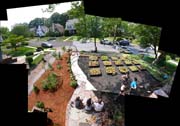 Edible Estate Regional Prototype Garden #3: Maplewood, New Jersey, established July 8th, 2007 / as viewed from the upstairs bedroom
Edible Estate Regional Prototype Garden #3: Maplewood, New Jersey, established July 8th, 2007 / as viewed from the upstairs bedroom

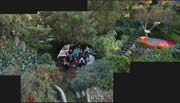 Sundown Salon #22: Janfamily “How to be Taken Away” / embroidering in the garden all day and evening / October 30th, 2005
Sundown Salon #22: Janfamily “How to be Taken Away” / embroidering in the garden all day and evening / October 30th, 2005
 Bernardi Residence / Silverlake Hills, Los Angeles / under construction, to be completed summer 2007 / view of gathering room
Bernardi Residence / Silverlake Hills, Los Angeles / under construction, to be completed summer 2007 / view of gathering room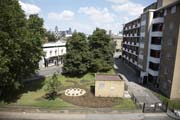 Edible Estate Regional Prototype Garden #4: London, UK established May 27th, 2007 / commissioned by the Tate Modern / view from the flat of the resident of a neighboring council estate, June 2007
Edible Estate Regional Prototype Garden #4: London, UK established May 27th, 2007 / commissioned by the Tate Modern / view from the flat of the resident of a neighboring council estate, June 2007 Edible Estate Regional Prototype Garden #4: London, UK established May 27th, 2007 / commissioned by the Tate Modern / planting weekend with council estate residents
Edible Estate Regional Prototype Garden #4: London, UK established May 27th, 2007 / commissioned by the Tate Modern / planting weekend with council estate residents
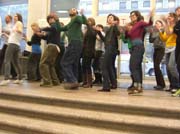
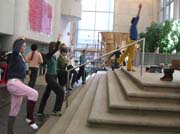 Sundown Schoolhouse: Dancing 9 to 5 at the Whitney Museum of
Sundown Schoolhouse: Dancing 9 to 5 at the Whitney Museum ofFritz Haeg: I have always been interested in plants and gardens, but it wasn't until I moved to Los Angeles in 1999 that I become truly consumed by it, and it found its way into my practice. I'm mostly interested in gardens for what they represent and for what they are uniquely able to do. A healthy edible garden in its truest form is one of the few places we see human need vs. natural resource reconciled with total clarity in front of us. We can see the fragile balance played out. I think highly visible and diverse gardens should be everywhere that people are. They keep us in check and remind us that we are entirely dependant organisms but also empowered custodians.
With the Edible Estates regional prototype gardens I am removing unused, toxic, polluting, water-guzzling no-mans-land spaces and replacing them with productive edible gardens. People are back on the streets reconnected to their local ecology, food and neighbors. I'm interested in what happens when a garden is placed in a location where it becomes a threat to the industrial/commercial system that we are embedded in. For some neighborhoods, it is a very provocative gesture that is upsetting. I think that a society that cannot grow it's own food or that is threatened by a garden is in deep trouble.
NT: Not to be a complete Marxist, but it appears you are attempting to deal with the alienation one feels from being separated from the total outcome of production. That in growing a garden, one becomes in tune with the cycles of food production that keeps him alive. Along with the macro-political components, do you find this approach has personal therapeutic effects?
FH: I have very vivid and emotional memories of my first few months gardening in Los Angeles. I became extremely attuned to the local climate, geography, geology, flora and fauna. It was such a contrast to the New York world of people, commerce, abstraction and speculation that I was coming from.
Just the act of spending an extended period of time outside with your hands in the dirt is a profoundly “deviant” act today! There is no rational or practical reason to do it. We can get anything we need at the store, right? Why are we still mucking around in the dirt? There must be something we still need there…
NT: You have many projects going at once - your studio, Gardenlab, Sundown Schoolhouse, and Edible Estates. Why do you work in multiple forms and how does this assist your process?
FH: This diverse practice confused me when I lived in New York. I have since realized that these parallel paths are perhaps at the heart of my practice, and I have let it run its course. Now I just do what ever I feel like I need to do without worrying if I am 'qualified', or what it might mean to the rest of the work. It's very liberating. I have no idea what I will be doing next year, and that’s fine.
Making buildings, dances, gardens, events, or a school may seem like a crazy mess, but recently it seems to me that the work is converging on a very focused series of thoughts about our relationship to each other and our environment at this moment in our civilization.
I guess it's also like crop rotation. When I’m exhausted, I don't sit around and wait, I just slide over to the next thing.
NT: I am clearly a fan of an aesthetic practice unafraid to take on multiple forms from community building to hermetic gesture to straight up classroom. These forms have a long history with grassroots activism. What are your personal inspirations for a multi-faceted practice?
FH: I believe that if I allow myself to surrender daily to what I am drawn to, no matter how confusing or strange, it will be good for me and my work. Mmmmmm, is that a lesson I learned from being gay?!
I want to wake up every morning and have a place in my practice for whatever it is I feel like I need to do that day: manual labor, writing, meeting people, dancing, drawing, computer work, gardening, traveling, making spaces… I want a practice that allows me to spend my time in an infinitely diverse way. I want to create a practice the same way that I would create any project. It should age well, evolve with my changing interests and obsessions, but at the same time maintain a conceptual and principled focus that transcends media or material.
Buckminster Fuller believed that specialization and trades were a form of slavery instituted by “the man” (he called them the pirates) to prevent any one person from seeing the big picture, which would be a threat to their power.
NT: If it is possible to not be careerist in one’s response to questions regarding his professional practice (the need to turn aesthetic ideas into money to live), how do you see your work in regard to paying the bills versus making meaning in the world?
FH: I am very interested in the real economics involved once you deviate from the commercial conventions of the art and design world.
Most of the work I have been doing never paid until recently. For years I supported myself mostly by teaching and some modest architecture fees for small projects. Now I teach occasionally and I support myself from (in descending order) architecture design fees from the few projects I do, artist commission fees from museums, occasional teaching salaries, speaking honorariums, writing, and a bit from the Sundown Schoolhouse. The amount I actually earn from any one of them varies wildly, so I do what I do and hope every thing balances out in the end. I’m always living right on the edge though. That uncertainty is the price of doing work that does not have a conventional market.
Along those lines, it is quite difficult to work with MFA students that will graduate $100,000 in debt. They enter into the world unable to take any real risks, or experiment in ways that may not pay off for years or have the luxury to fail spectacularly at something.
NT: What do you find to be the key issues regarding public space and how do you see aesthetic interventions being a benefit and a problem?
FH: Right now I am most interested in private spaces that have the capacity to be public. It’s not that I have given up on public space (though maybe I have!) but I do think that private property, and in particular the home, has become the focus of our society. We are obsessed with our homes as protective bubbles from the realities around us. Today's cities are engineered for isolation, so starting a salon in your living room or growing food in your front yard become ways to subvert this. Perhaps at this moment working from private space out may be more useful than working from public space in.
NT: I find that answer quite interesting actually. There are more than a few who consider the entire concept of ‘public space’ as deeply problematic as it tends to legitimate a large portion of the planet as inherently private. I also know from working in a museum that there are a lot of different possibilities when one owns the space in which experimental gestures are attempted, which might not be feasible in public. Yet, surely there are plenty of folks who do not own their front lawns. What are your thoughts in regard to renters or those without any private property whatsoever?
FH: Conversely I am also interested in “public” space that can be claimed and appropriated for private use. I especially like the idea of taking the least humane, most neglected and visible spaces in our cities and repurposing them for intimate human activity or nature interventions. For example I am reminded of my friends who do the Journal of Aesthetics and Protest that had a birthday party in the parking lot of Ralph’s (a grocery chain in Los Angeles). They also organized a wonderful neighborhood project in L.A.’s Highland Park a few years ago called October Surprise where they “took back the streets” and staged projects all over town with local organizations.
I am very ambivalent about the ”community project” though. It is a delicate matter to go into someone else’s neighborhood as the “enlightened artist” and impose on them your vision of what they need. With the garden that the Tate Modern commissioned me to do in Southwark (just south of the museum), I worked with a local organization that is based in the neighborhood. They were a vital link to the residents of the council estates where we did the project. I went door to door with them to talk to everybody about the edible garden I was planning. Even still, on my first day of work on the land, a woman who has lived in the building for 37 years came up to me demanding to know what I was going to do to their last piece of green space. When she found out I was from Los Angeles, she got even more suspicious….like “ok, let me get this straight, you come over here to screw up our green space & then go back to California?”. But I went to visit her when I had finished the garden and she was really delighted with it. It turns out she is an amazing painter and is now working on a portrait of the garden.
NT: You are currently planting an edible estate in a front lawn in New Jersey, how is that going?
FH: I just finished three brutal days of manual labor, turning sod by hand, shoveling dirt, lifting rocks. Every muscle in my body ached this morning. Fortunately I had about 20 volunteers turn up over the weekend to help out. It was fun and I’m really happy with the way the garden turned out. On one side of the front yard we installed 15 raised beds of vegetables and herbs and on the other we planted a mini orchard of fruit trees and vines. The neighbor next door (on this street of meticulously groomed lawns) was upset as soon as she heard about the plan, so I knew I had picked the right spot!
NT: I love the look of community gardens but I can in my heart see why people hate the idea of gardens in their neighbor’s front yard. It clearly disrupts the sense of public/private and I think for many people, particularly in front lawn friendly areas, they have worked hard for their deeply regressive sense of the private. Do the edible estates have a community outreach component? Maybe if they received some free peas or something they would calm down.
FH: When you live on the street with an Edible Estate, you see the owners out there gardening every day. You get to know them better than those with the lawn. You talk to them about how the crops are doing. They can’t possibly eat everything they are growing, so every time you pass by they are trying to unload the latest harvest of tomatoes or zucchini on you. Just the act of witnessing a garden grow can have a profound effect. When you watch daily as seeds sprout, plants mature and fruit is produced you can’t help but be drawn into the wonder of it. By being a witness, you have become complicit and are now part of the story.
> Return to Interrogating Public Space
![]()